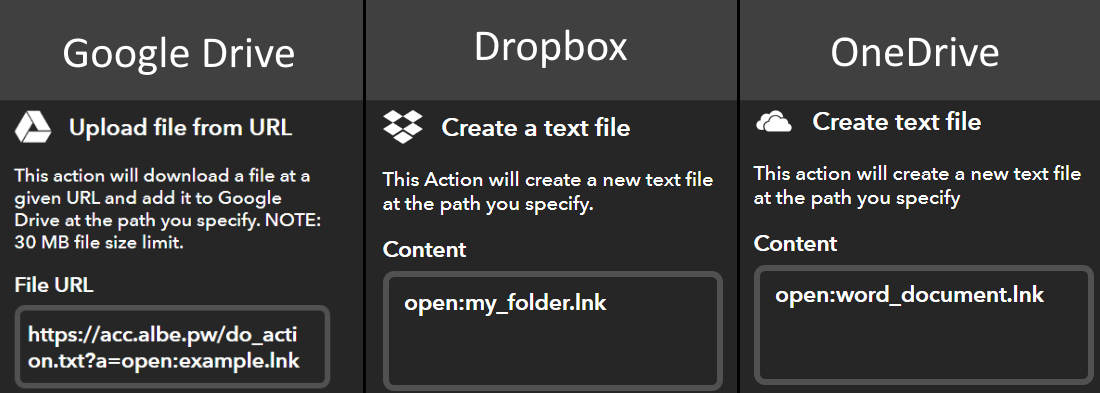How to use the "open" action
One of the most requested and appreciated actions is the open-action. In this guide, you will be taught how to master it!
What does it do?
It opens a file, a folder or everything in a folder - you decide!
Can open any file on your PC.
How?
The official AssistantComputerControl IFTTT page contains pre-made applets ("functions" or commands if you will) for the software, but the open action requires a bit more than just pressing "Enable". The [ACC] Open file (example) applet (find it for your assistant and cloud service here) requires you to tell it which file or folder you wish it to open. By default, the content of this applet is open:example.txt (for Dropbox and OneDrive), and executing it will open the file called "example.txt", which is located at Documents/AssistantComputerControl/shortcuts. For Google Drive the default content is; https://acc.albe.pw/do_action.txt?a=open:example.txt
The open: part (and everything before that for Google Drive) is required, and should stay, but everything after the colon (:) is where the magic happens.
Open files, folders or websites
Say you want to open a Word document or a folder. There are two ways we can do this.
1. Easiest one; we create a shortcut of the file or folder we want to open
Wherever you want to open a file or folder, we can just create a shortcut of it, and place it in a special ACC folder.
- Right-click it, hover "Send to" > "Desktop (create shortcut)".

Screenshot showcasing how to create a shortcut
-
Rename this shortcut to a name with no spaces or capital letters.
Good name;my_file
Bad name;My File -
A shortcut of a file or folder will always be a
.lnkfile (that's _L N K, not I N K)_ -
This will create a shortcut to the file/folder on your desktop. Drag this new shortcut-file into the following folder;
Documents/AssistantComputerControl/shortcuts -
Now in the applet you have to edit the "content" field if you're using Dropbox or OneDrive, and the "File URL" field if you use Google Drive.

Screenshot showcasing the different cloud services with the open action
-
Done! You can now open files and folders!
For each new file or folder you wish to be able to open using ACC, you will have to make your ownopenapplets. Check the "Making your own applets" guides.
-
Extra notes
-
If you want to open a website (URL in your default browser), you can go to your browser, select the URL and drag it to your desktop. This will create a file called
the_website_name.url- move this to the shortcuts folder (Documents/AssistantComputerControl/shortcuts) and change theopenaction toopen:the_website_name.url -
Steam games; if you wish to open games from steam, these are saved as "Internet Shortcuts" (URL) and not LNK. All your steam games are located at;
%appdata%\Microsoft\Windows\Start Menu\Programs\Steam- simply copy the game you want to open into the ACC shortcuts folder and change the applet content to;open:steam_game_name.url -
If you don't care where the file/folder is located, you can just permanently move it to the ACC shortcuts folder and not have to open it as a
.lnkfile, but use the real extensions. Example; there's a file calledexample.txtin the shortcuts folder by default. To open this, the content of the applet should beopen:example.txtand NOTexample.lnk -
Google Drive notes:
Here the "File URL" has to be;https://acc.albe.pw/do_action.txt?a=open:and then the file/folder you wish to open. Example;https://acc.albe.pw/do_action.txt?a=open:my_word_document.lnk -
Troubleshooting
If the file fails to open, make sure your file is NOT calledfilename.lnk.lnk- the fileNAME should not be.lnk, the extension should be.lnk. To check whether your file is calledfilename.lnkorfilename.lnk.lnk, right click the file and go to the "General" tab in "Properties". Here, it should look like this;
-

2. Use the full path to the file/folder (doesn't work for Google Drive)
If you for some reason don't want to create a shortcut, but rather want to access the file with its full path, you can do this too. Simply write the full path after open:
Opening folders was added in release v1.1.0
Updated about 6 years ago
